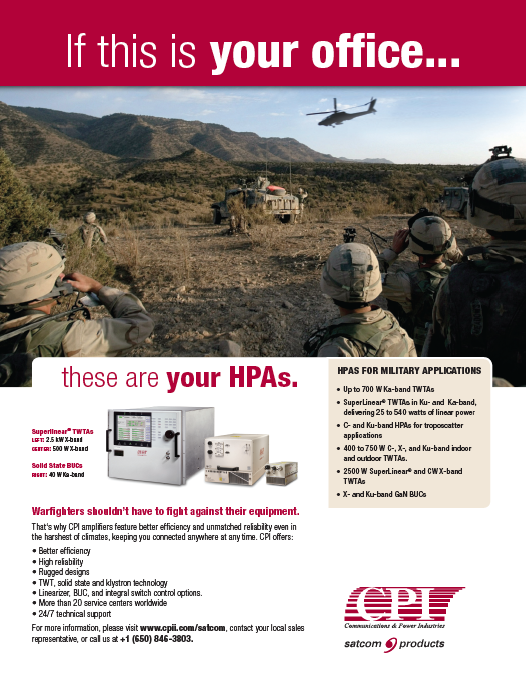Droning On @ NIE
In this season’s Network Integration Evaluation, or NIE, taking place on White Sands Missile Range, or WSMR, and Fort Bliss, Texas, coordinated units of remotely-operated and automated aircraft will be used to represent a possible threat on tomorrow’s battlefields.
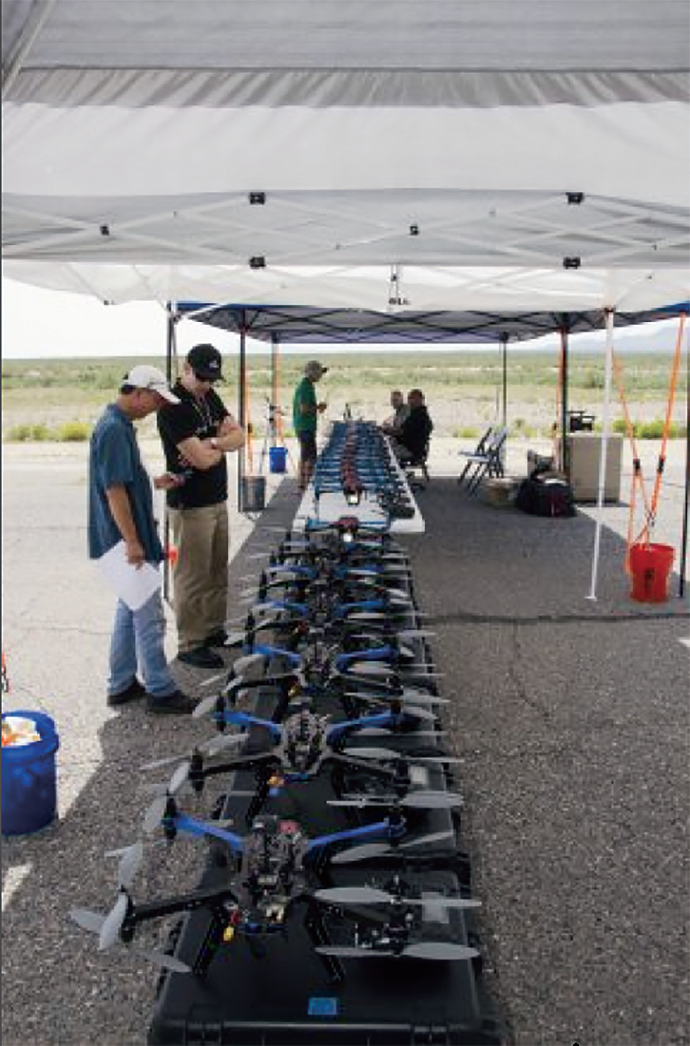
Members of the Targets Management Office with Program Executive Office for Simulation Training and Instrumentation, or PEO STRI, are using off-the-shelf quad and octocopters and flying them in groups. The endeavor is part of an Army Test and Evaluation Command, or ATEC, program to study possible use, effectiveness and countermeasures for the deployment of large numbers of synchronized drone aircraft.
“ATEC is our customer, they tasked us to come out and look at swarming, the variations and the payloads we can apply to this,” said James Story, an engineer with the Targets Management Office, PEO STRI. “We saw this as a threat that wasn’t being addressed and ATEC agreed.”
While drones are seeing expanded use, with many different countries building, deploying, and selling large airplane-sized drones for military purposes, small-scale drones are still gaining a foothold, mostly due to the technical limitations involved. That technology is expected to improve, and the small-scale drone become more viable as a possible weapon, and it’s that preparation for the future that is driving the swarming project.
“Right now there’s hardly anyone doing swarms, most people are flying one, maybe two, but any time you can get more than one or two in the air at the same time, and control them by waypoint with one laptop, that’s important,” Story said. “You’re controlling all five of them, and all five of them are a threat.”
Normally used by hobbyists and photographers, the quadcopter style drones don’t represent a huge threat in their current state. The tiny aircraft have a flight time of only a few minutes, and have a limited payload capacity. This makes them ill suited for the surveillance missions drone aircraft are most commonly associated with, which require an aircraft that can stay aloft for long periods of time, and carry heavy zoom and thermal camera systems.
The concern comes from the affordability of the off-the-shelf systems. Small military drones, custom designed for the military mission, and outfitted with the latest hardware can get quite expensive.
The Tarantula Hawk Micro Air Vehicle, a VTOL capable military drone about the size of a large bucket, comes with a price tag in the hundreds of thousands of dollars, with hundreds of thousands more needed to train an operator. An off-the-shelf quadcopter, like the 3-D Robotics Iris series used in the test, can be bought for around $1,000, and requires almost no training to operate.
For the NIE, the off-the-shelf drones will be configured to carry special payloads for specific mission functions. Cameras, bomb simulators, expanded battery packs and other systems will be tested on the aircraft to develop and analyze potential capabilities of the drones.
By conducting the flights at WSMR, the engineers can evaluate things like actual flight time and performance, as well as payload capabilities. Using data collected from the WSMR flights, the engineers hope they can increase the flight time of the drones, and make other improvements to make them more comparable to more expensive military drones.
“The payloads make the difference. When you add video, the camera, the heavier battery for more flight time ... so for the smaller bird here the flight time goes from about 15 minutes, to about seven minutes of flight time,” Story said. “That’s part of what we’re doing here is seeing if we can increase the flight time.”
From a military perspective, this low price tag of the off-the-shelf drones can translate to a level of disposability. A militarized version of one of these aircraft could be equipped with light weapons like small bombs they can drop, or be flown into a target and exploded like a cruise missile.
Even still, the threat of a single drone of this type is fairly small, as they lack hardened systems and armor, making them easy to shoot down using even a simple sportsman’s shotgun. By coordinating dozens of drones or more into a single swarm, it’s theorized the tiny aircraft could overwhelm a defender, presenting far more targets then can be easily destroyed and allowing at least some weaponized drones to reach their target.
“Even if you defeat one or two, if one of them slips past the guard that can pose a problem,” said Michael Francis, integrated product team lead for the multirotor targets program.
In preparation for the NIE mission, PEO STRI came to WSMR in September to conduct initial flight tests at Condron Army Airfield. Using flight and navigation software also available off-the-shelf, the engineers and technicians were able to put up to 10 drones in the air at a time, conducting basic maneuvers and formations, and return to the launch point. While simple in appearance, the ability to put 10 drones in the air and execute a flight plan is a key step in the development and analysis of swarm tactics.
For the NIE, PEO STRI personnel will be deploying the drones as a kind of fire support unit.
Acting as a member of the opposing force, the drones will be used for short-range missions, flooding the airspace with drones to generate disruptive radar signatures, as well as being used as a kind of spotter, using simple video cameras to try and locate Soldiers and units.
“We’re going to be flying proving the opposing force with swarm type assets, giving them radar saturation and getting eyes on using a video downlink,” Francis said.
There’s also plans to fit the drones with the ability to drop packets of flour, simulating the ability for the swarm to drop small bombs, allowing the drones to perform short-range strike missions.
Drone-test missions can be a big challenge to plan and execute. Fortunately WSMR has unrestricted military airspace, allowing the testing of remotely operated or autonomous aircraft at any altitude within the range’s 3,200 square miles.
Certifying the systems through WSMR’s flight safety office, establishing safe operations procedures was challenging, but the result is the ability to evaluate a new threat to the Soldier.
U.S. Army Engages In Network Exercise With Partner Nations
The Network Integration Evaluation, or NIE 16.1, was the largest such event ever conducted, since the exercises started in 2011, said Brig. Gen. Terry McKenrick, Commanding General, Brigade Modernization Command.
Normally, there are between 3,500 and 3,800 participants—NIE 16.1 has more than 9,000 U.S. and coalition soldiers, supported by more than 3,000 civilians participating primarily at Fort Bliss, but also other locations around the U.S. and the world.
Among the many Army units participating this time are I Corps Headquarters; 1st Armored Division Headquarter, along with several 1st Armored Division brigades; a brigade headquarters from the United Kingdom, along with a company of Strykers being used by the United Kingdom’s Scots Guards; 82nd Airborne Division, which will conduct a joint forcible entry; and, 101st Airborne Division, which will conduct an airborne assault.
The U.K. and Italy join U.S. units on the ground with 12 other nations, as well as other U.S. military units, some of which will participate virtually, using a variety of simulations.
Some 300 platforms, including just about all the vehicles in the Army’s inventory, as well as experimental vehicles, loaded with a of radios, satellite communications gear and mission command applications, are being evaluated, along with radios carried by dismounted Soldiers, McKenrick said.
NIE 16.1 is assessing manned and unmanned teaming—the ability to increase situational understanding, lethality, and sustainment of maneuver forces while reducing manpower and risk, he said. In all, three unmanned ground systems are being evaluated, as well as several networked unmanned air systems.
Network provides the ability for Soldiers in command posts, mounted and dismounted to download situational awareness data from the unmanned air systems.
While NIE 16.1 is about experimentation, an equally valuable focus will be on readiness, McKenrick said. The realistic training will be equivalent to a combat training center rotation, with a hybrid threat featuring combined-arms maneuver and wide-area security against an opposing force. Weapons of mass destruction scenarios will also
be incorporated.
McKenrick said the Army is now going through an “assessment process” of accrediting White Sands-Bliss-Holloman as a “joint-multinational training capability. That will help us bring in more joint and multinational partners in future exercises.”
Now and in the future, the Army will operate as part of a joint and coalition force, he said. It’s spelled out in the Army’s keystone doctrine known as the “Army Operating Concept: Win in a Complex World.” To do that effectively requires compatibility across network architectures that each of the armies use, he said. That’s why this exercise and getting it right is so important to the U.S. and its partner nations.
Besides Fort Bliss, the exercise will also spill over to adjacent Holloman Air Force Base and White Sands Missile Range, both in New Mexico. To give sense of scale, White Sands is 3,200 square miles, Fort Bliss 1,700, while the entire state of Rhode Island is a mere 1,214.
NIE 16.1 will be different from any other previous NIE, McKenrick said. NIE 16.1 will be the “final proof of concept” for a new annual exercise, which will start at the beginning of fiscal year 2017. That new exercise will be called the Army Warfighting Assessment, or AWA, with the first being AWA 17, which will be conducted in October 2016.
NIE 16.1 and AWA will not focus on the traditional NIE programmatic testing required for systems to become or not become programs of record, or go back into development, he said. AWA-17 will focus on 38 concepts and capabilities that U.S. Army Training and Doctrine Command, or TRADOC, identified, he said.
Strict testing requirements, in other words, will be lifted to give industry and the Army’s own lab engineers the freedom to explore new capabilities with Soldier feedback in realistic settings.
NIE 16.1 and AWA will focus on experimentation involving integration of U.S. and coalition networks to see what works, what doesn’t, why it doesn’t, and what solutions might be possible.
Another difference between NIE 16.1/AWA and past NIEs, is that there will be a lot more stakeholders present on the ground, said McKenrick. They include the requirements and acquisition communities, TRADOC and industry partners, as well as eight of the Army’s centers of excellence, with heavy participation from the Mission Command, Maneuvers, Fires and Cyber CoEs. It will be a “truly collaborative environment, a team-of-teams effort.”
Development Centers will be eliciting Soldier feedback on some 73 systems, reviewed by Plans and Operations, Army G-3/5/7, that will be evaluated, he said. Also, TRADOC will be looking to see how new technology could drive doctrine and how doctrine could influence new technology.
New technology could be software, hardware, app-like devices, security solutions, wireless capability to replace hardwiring, energy-saving devices and so on— items needed to enable the Army to be more expeditionary, a key cornerstone of Force 2025 concept.
While this year’s NIE has heavy NATO participation, next year’s will focus more on partner nations within the U.S. Pacific Command’s area of responsibility, McKenrick added. Sea-basing, along with Marine Air-Ground Task Force experiments, will be included as well. Units are still being identified that will participate. Australia has already “signed up.”
Story by Vanessa Flores, ASA(ALT) System of Systems Integration Director Public Affairs SOSI
Extended Combat Training Required Open Lines Of Communication For 648th RSG
Soldiers with the 648th Regional Support Group (RSG) participated in a war simulation recently for their Extended Combat Training.
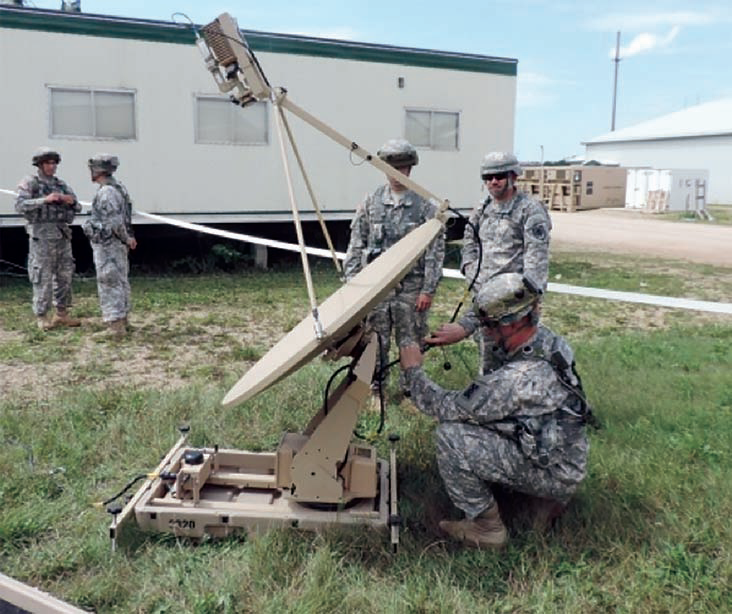
Soldiers with the 648th Regional Support Group set up and train with a Very Small Aperture Terminal Satellite during a war exercise at Fort McCoy, Wisconsin. Photo by Staff Sgt. Francis Horton.
During ECT, the soldiers mixed real world scetnarios and war games; managing the needs of the Forward Operating Bases
they oversaw and reacting to daily simulated attacks.
“Our job...was to provide for the defense and collaboration between multiple FOBs,” said Lt. Col. Greg Atwood, S3 Officer, 648th RSG.
These duties include making sure the FOBs have the necessities to support their Soldiers, such as food, laundry and bath facilities, water and other necessities, Atwood said.
Meanwhile, the 648th reacted to simulated mortars, improvised explosive devices and small arms fire.
Of course, no training mission is complete without its challenges.
“Probably the biggest challenge of all was having less than half of our staff,” said Lt. Col. Jan McCall, Deputy Commander, 648th RSG.
The 648th has around 99 soldiers assigned, but only 44 went to ECT, meaning many had to work long hours and take on extra duties.
“I learned something new that’s outside of my job. Sometimes it’s good to know more than just your job,” said Pfc. Darqeisheona Howard, administrative specialist, 648th RSG.
“At first I was kind of iffy about it,” Howard said. She was hoping to work more within her military occupational specialty.
Due to personnel shortages however, Howard found herself in a job position she wasn’t trained for. Rather than handling administrative duties, she was trained on the spot as a radio telephone operator, keeping lines of communication open between the FOBs, she said.
There was also an issue with the Personnel Status Report which tracks how many soldiers are supposed to be in the training area, McCall said.
“We took over for another Regional Support Group. There were a little over 1200 unaccounted soldiers,” McCall said.
She and her staff worked long hours contacting the leaders of their subordinate FOBs to account for every soldier assigned to the exercise.
ECT also gives soldiers a chance to expand their knowledge and build better leadership skills.
“This training has made me grow as a leader and has shown me what the flow of information is like in a theater environment.” said Sgt. 1st Class Floyd Glasco, Engineer Operations noncommissioned officer.
One of the most important parts of any exercise is the morale and well-being of the soldiers.
“I also keep up my soldiers’ morale,” Glasco said with a smile. “If I don’t make Spc. Dunn laugh just once a day, then I am not doing my job.”
Story by Staff Sgt. Francis Horton, 363rd Public Affairs Detachment, U.S. Army
High Throughput SATCOM That Leverages Existing Ku-Band Hardware
Mobil Satellite Technologies announces the company has launched a new, high-bandwidth, 10 Mbps download x 4 Mbps
Ku-band service for use anywhere in the North America.
This iDirect compatible service offers a great solution for users requiring high-throughput satellite performance while leveraging existing Ku-band hardware.
Ku-band service operates with longer wavelengths, giving Ku-Band a superior ability to perform through inclement environmental conditions.
The Mobil Satellite Technologies satellite network has been configured to support this new service with 1.2 meter antennas with only an 8 Watt BUC, which are now available in a small, fan-less form factor that no longer require auxiliary power supplies that allows a simple replacement of the existing BUCs on almost any mobile or fixed 1.2 meter VSAT antenna.
Kirk Williams, Direcor of Sales at Mobil Satellite Technologies, commented: “This new service gives users the ability to upgrade to an extremely robust satellite broadband service while continuing to use their existing Ku-Band equipment. Before this new service, users would have had to buy all new Ka-band satellite hardware to have access to service plans offering these kinds of data speeds.”
“Programs and applications that require large amounts of bandwidth are becoming more and more common, so satellite network operators need to keep up. With this new 10 MB service on our proven iDirect network, we can deliver the enterprise-grade, high-throughput satellite service plans that users are asking about.” said Bud Burton, President of Mobil Satellite Technologies. “This is just another step in our mission to deliver the best possible service and the very latest features to our customers.”
DARPA Seeking Gremlins Assistance
For decades, U.S. military air operations have relied on increasingly capable multi-function manned aircraft to execute critical combat and non-combat missions.
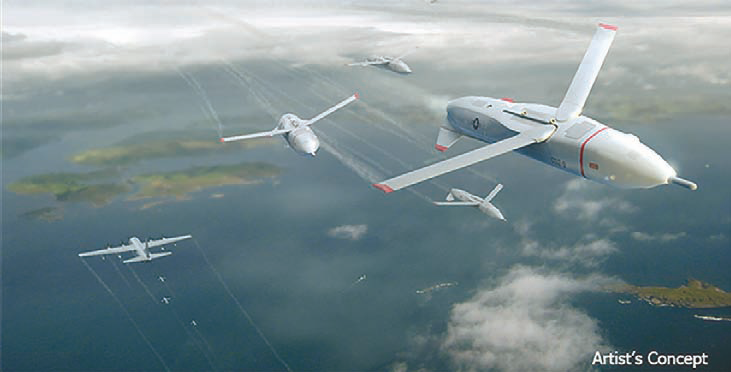
Adversaries’ abilities to detect and engage those aircraft from longer ranges have improved over time as well, however, driving up the costs for vehicle design, operation and replacement.
An ability to send large numbers of small unmanned air systems (UAS) with coordinated, distributed capabilities could provide U.S. forces with improved operational flexibility at much lower cost than is possible with today’s expensive, all-in-one platforms—especially if those unmanned systems could be retrieved for reuse while airborne. So far, however, the technology to project volleys of low-cost, reusable systems over great distances and retrieve them in mid-air has remained out of reach.
To help make that technology a reality, DARPA has launched the Gremlins program. Named for the imaginary, mischievous imps that became the good luck charms of many British pilots during World War II, the program seeks to show the feasibility of conducting safe, reliable operations involving multiple air-launched, air-recoverable unmanned systems.
The program also aims to prove that such systems, or “gremlins,” could provide significant cost advantages over expendable systems, spreading out payload and airframe costs over multiple uses instead of just one.
“Our goal is to conduct a compelling proof-of-concept flight demonstration that could employ intelligence, surveillance and reconnaissance (ISR) and other modular, non-kinetic payloads in a robust, responsive and affordable manner,” said Dan Patt, DARPA program manager.
The Gremlins program seeks to expand upon DARPA’s Request for Information (RFI) last year, which invited novel concepts for distributed airborne capabilities.
It also aims to leverage DARPA’s prior success in developing automated aerial refueling capabilities, as well the Agency’s current efforts to create advanced UAS capture systems for ships.
The program envisions launching groups of gremlins from large aircraft such as bombers or transport aircraft, as well as from fighters and other small, fixed-wing platforms while those planes are out of range of adversary defenses. When the gremlins complete their mission, a C-130 transport aircraft would retrieve them in the air and carry them home, where ground crews would prepare them for their next use within 24 hours.
DARPA plans to focus primarily on the technical challenges associated with safe, reliable aerial launch and recovery of multiple unmanned air vehicles. Additionally, the program will address new operational capabilities and air operations architectures as well as the potential cost advantages.
With an expected lifetime of about 20 uses, Gremlins could fill an advantageous design-and-use space between existing models of missiles and conventional aircraft, Patt said. “We wouldn’t be discarding the entire airframe, engine, avionics and payload with every mission, as is done with missiles, but we also wouldn’t have to carry the maintainability and operational cost burdens of today’s reusable systems, which are meant to stay in service for decades,” he said.
Moreover, gremlin systems could be relatively cost-efficient if, as expected, they leverage existing technology and require only modest modifications to current aircraft.
The DARPA Special Notice that describes the specific capabilities sought is available at http://go.usa.gov/36ARH.
The Gremlins program plans to explore numerous technical areas, including:
• Launch and recovery techniques, equipment + aircraft integration concepts
• Low-cost, limited-life airframe designs
• High-fidelity analysis, precision digital flight control, relative navigation and station keeping
Proposers are encouraged to explore these areas as well as other technologies that could help the program achieve its goals.
Predicting The Weather Patterns For The Air National Guard
Pilots in the Air National Guard must be aware of a number of different factors when they fly.
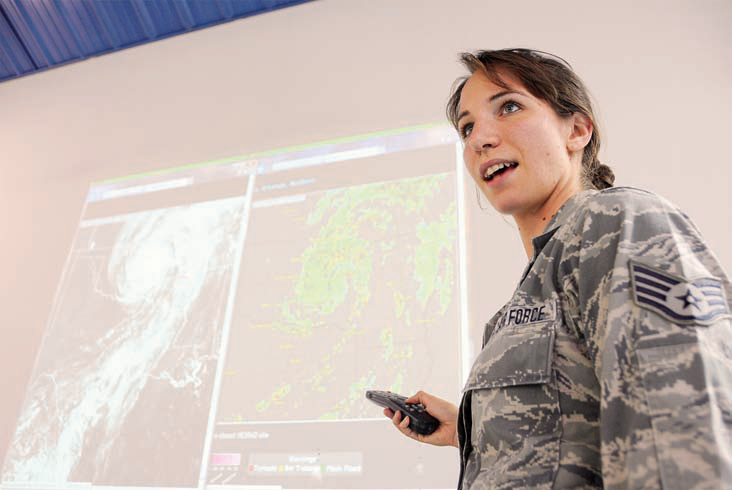
Staff Sgt. Jennifer Burgos, weather forecast apprentice, explains the effects of Tropical Depression Bill June 18, 2015, during a presentation provided at Ebbing Air National Guard Base, Fort Smith, Arkansas. Weather forecasters analyze weather conditions, prepare forecasts, issue weather warnings and brief weather information to pilots. U.S. Air National Guard photo by Senior Airman Cody Martin.
However one of the biggest variables to consider is the weather. To combat the unpredictable, the ANG has weather forecasters to keep pilots informed of conditions in real-time helping to play a vital role in ensuring flight plans are as safe as possible.
As part of the mission conversion here, weather forecasters are preparing to switch gears for a new type of pilot and plane—the remotely piloted aircraft.
Weather specialists in the ANG are responsible for predicting weather patterns and preparing forecasts to brief pilots and commanders on weather conditions, which can often make the difference between performing a mission or standing down.
Before the conversion to an RPA and intelligence, surveillance and reconnaissance mission, 188th Wing weather forecasters predicted weather patterns for A-10C Thunderbolt II “Warthog” pilots.
“The good thing with the RPA is you get live feed,” said Tech. Sgt. Joseph Williams, weather forecast specialist. “You can use that to your advantage and see storms rolling in, or see what level the clouds are at and adjust your forecast for that.”
A unique advantage that the RPA provides is with its live feed. The live feed can be viewed on multiple monitors during flight, providing a distinct accessibility. Pilots of the A-10 can contact forecasters via radio, but it does not provide the efficiency of live feed that can be analyzed during an RPA pilot’s flight.
“One of the advantages [sensors] provide is that it gives us more eyes in the sky,” said Staff Sgt. Jennifer Burgos, weather forecast apprentice.
Weather specialists have to be cautious of the affect weather can have on RPAs. Sand and dust storms, clouds above freezing level and other types of weather can impact the visual sensors. Overseas, weather forecasters pool satellite data to deter negative impacts to the mission due to weather.
“Satellite may be one of our only tools overseas, but it’s an amazing tool to have,” Williams expressed. “You can see what’s going on in the atmosphere through all of our satellites, which helps exponentially when it comes to mission planning and sharing information.”
Face-to-face communication is a huge advantage to the ISR field that the 188th Wing will be providing, and weather specialists will benefit just as much from this opportunity.
Members of the 188th ISR Group will be housed in one building to enhance efficiency and accelerate the speed of information to the RPA pilots.
Weather forecasters at the 188th get the unique chance to obtain information on the weather the pilot is flying in and either walk over or speak through the radio to get that critical information to them.
“It is a lot easier to get pilots’ information because everybody knows that weather changes rapidly in any location, here or overseas,” Williams stated. “If you have a pilot who’s flying a mission thousands of miles away and you can walk over or get on your radio and talk to the pilot about what you just saw, it is a huge benefit and can save assets.”
The mission of weather specialists within the 188th and the Air National Guard is essential to pilots and their aircraft in completing key mission objectives. Their success shows that the ANG is an inseparable part of the total force and a proven choice for the warfight.
Ebbing Air National Guard Base, Fort Smith, Arkansas—Story by Senior Airman Cody Martin, 188th Wing, U.S.A.F.





